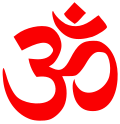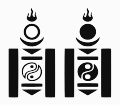Anusvara (Sanskrit: अनुस्वार, IAST: anusvāra), also known as Bindu (Hindi: बिंदु), is a symbol used in many Indic scripts to mark a type of nasal sound...
18 KB (1,650 words) - 06:59, 12 June 2024
the previous vowel is nasalized. In Hindi, it is replaced in writing by anusvara when it is written above a consonant that carries a vowel symbol that extends...
4 KB (192 words) - 14:00, 23 August 2023
Malayalam script (section Other Anusvaras)
vowel. In general, an anusvara at the end of a word in an Indian language is transliterated as ṁ in ISO 15919, but a Malayalam anusvara at the end of a word...
65 KB (5,582 words) - 16:54, 10 August 2024
transliterate anusvara as ṁ, while ALA-LC and IAST use ṃ for it. However, ISO 15919 provides guidance towards disambiguating between various anusvara situations...
35 KB (712 words) - 19:32, 19 August 2024
Thai script (section Nikkhahit (anusvāra))
write Sanskrit or Pali, and not used in writing Thai. In Sanskrit, the anusvāra indicates a certain kind of nasal sound. In Thai this is written as an...
99 KB (5,605 words) - 14:04, 19 August 2024
the final nasal anusvāra ं ṃ and the final fricative visarga ः ḥ (called अं aṃ and अः aḥ). Masica (1991:146) notes of the anusvāra in Sanskrit that "there...
104 KB (6,889 words) - 19:41, 22 August 2024
in the flexional endings including: -īhi, -ūhi and -īsu A sound called anusvāra (Skt.; Pali: niggahīta), represented by the letter ṁ (ISO 15919) or ṃ (ALA-LC)...
92 KB (10,543 words) - 12:14, 15 August 2024
The overdot is also used in the Devanagari script, where it is called anusvara. In mathematics and physics, when using Newton's notation the dot denotes...
22 KB (1,848 words) - 15:05, 22 August 2024
Sanskrit grammar (section Visarga and anusvāra)
ha·l Pāṇini, The Aṣṭādhyāyī Visarga ḥ ः is an allophone of r and s, and anusvara ṃ, Devanagari ं of any nasal, both in pausa (i.e., the nasalised vowel)...
48 KB (4,547 words) - 22:12, 12 August 2024
Harvard-Kyoto (section Anusvāra and visarga)
The vowels table, the significant difference is for the sonorants and Anusvāra, visarga are capitalized instead of their diacritics. Finally, it is fairly...
8 KB (627 words) - 07:55, 15 March 2024
is a conditioned variant of n occurring next to palatal obstruents. The anusvara that Sanskrit deploys is a conditioned alternant of postvocalic nasals...
307 KB (32,164 words) - 19:31, 18 August 2024
Sanskrit accusative case ending, which is also /m/ (or, allophonically, anusvara due to the requirements of the sandhi word-combining rules) in the neuter...
163 KB (13,728 words) - 05:22, 21 August 2024
prodelision of the initial vowel.) Om may also be written ओं, with an anusvāra reflecting the pronunciation of [õː] in languages such as Hindi. In languages...
90 KB (8,496 words) - 20:51, 21 August 2024
syllables. In contrast, bija mantras are one-syllabled, typically ending in anusvara (a simple nasal sound). These are derived from the name of a deity; for...
93 KB (11,172 words) - 19:42, 8 August 2024
Brahmic scripts used for most Indic languages mark nasalization with the anusvāra (◌ं), homophonically used for homorganic nasalization in a consonant cluster...
11 KB (1,232 words) - 15:14, 9 August 2024
which are treated as vowels and may be short or long, and two part-vowels, anusvara ⟨◌𑌂⟩ ṁ and visarga, ⟨◌𑌃⟩ ḥ. Independent vowel letters are used for word-initial...
27 KB (1,767 words) - 18:49, 1 August 2024
consonants ಙ (ṅa), ಞ (ña), ಣ (ṇa), ನ (na), and ಮ (ma) are usually written as an anusvara ಂ when preceding another consonant rather than a consonant conjunct. For...
45 KB (1,658 words) - 10:40, 2 August 2024
WX notation (section Anusvāra and visarga)
This article contains Indic text. Without proper rendering support, you may see question marks or boxes, misplaced vowels or missing conjuncts instead...
5 KB (473 words) - 23:05, 15 November 2023
Sanskrit texts. In the traditional order of Sanskrit sounds, visarga and anusvāra appear between vowels and stop consonants. The precise pronunciation of...
7 KB (790 words) - 14:43, 3 June 2024
by diacritic marks. Long vowels are marked with the diacritic ⟨𐨌⟩. An anusvara ⟨𐨎⟩ indicates nasalization of the vowel or a nasal segment following the...
29 KB (2,439 words) - 16:56, 20 August 2024
अं ṁ (anusvāra) अः ḥ (visarga) अँ m̐ (candrabindu) अऀ (inverted candrabindu) ऽ ’ (avagraha) क़ (nuqta) क् (virāma) ३ 3 (pluta) ᳵ ẖ (jihvāmūlīya) ᳶ ḫ (upadhmānīya)...
4 KB (135 words) - 00:09, 24 April 2024
well as the retroflex ⟨ဏ⟩ /ɳ/ (used in Pali loans) and nasalisation mark anusvara demonstrated here above ka (က → ကံ) which most often stands in for a homorganic...
98 KB (9,474 words) - 12:14, 20 August 2024
strictest sense of the term" and its orthography too is inconsistent about anusvara, visarga, notation of double consonants and the ḷ retroflex. These and...
15 KB (1,028 words) - 17:23, 2 February 2024
SLP1 (section Anusvāra/Visarga)
The Sanskrit Library Phonetic basic encoding scheme (SLP1) is an ASCII transliteration scheme for the Sanskrit language from and to the Devanagari script...
5 KB (390 words) - 11:02, 11 May 2024
combining candrabindu nasal vowel diacritic of the Telugu script. ఄ: Combining anusvara above. ౷: Siddham sign. ౿: Tuumu sign. There are five classifications of...
51 KB (1,420 words) - 14:46, 19 August 2024
a vowel length marker, a diphthong marker, and one of the diacritics, anusvara or visarga. Soyombo contains the full set of letters to reproduce Mongolian...
17 KB (1,163 words) - 07:21, 9 August 2024
Characters include both human and talking animal characters. The letter ṃ (anusvara) in Hindi usually represents a nasal consonant homorganic with the following...
16 KB (2,187 words) - 19:32, 24 June 2024
Unlike Sanskrit, anusvara has great importance in Konkani. A characteristic of Middle Indo-Aryan dialects, Konkani still retains the anusvara on the initial...
103 KB (11,377 words) - 15:13, 12 August 2024
virtually replaced the old method of punctuation. Telugu has full-zero ("anusvāra" or "sunna" ) ( ం ), half-zero ("arthanusvāra" or "candrabindu" or "ara-sunna"...
130 KB (11,231 words) - 10:40, 19 August 2024
transcription, so they are not always included in the Odia alphabet. The anusvara and candrabindu diacritics are used to indicate nasalisation. A visarga...
60 KB (2,387 words) - 16:40, 28 July 2024














